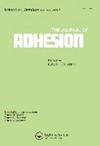盐水中负载下聚氨酯/Monel 400界面剥离行为
IF 2.3
4区 材料科学
Q2 ENGINEERING, CHEMICAL
引用次数: 0
摘要
采用自重剥离试验研究了盐水和电缆重量对聚氨酯/蒙奈尔400界面粘接能的耦合影响。电缆在海军结构中扮演着中枢神经系统的重要角色。电缆及其接头一般采用聚氨酯成型、封装或灌封,以保证电缆及其接头的绝缘和防水。在使用过程中,一些电缆及其连接器暴露在海洋环境中会导致连接器的聚氨酯/金属接口过早失效。为了更好地理解这一现象,我们进行了三组实验:初始90°固定臂剥离试验,以确定界面强度;在盐水中进行了悬挂重剥离试验,以确定重量变化和盐水降解的影响;在不同盐水温度下进行了自重剥离试验,以确定加速系数。根据研究结果,在空气中进行的剥离实验中没有记录到剥离,表明界面的强度高于剥离臂的强度。在自重剥离试验中,吊重质量的增加使剥离速度增大。此外,对于低剥离速度,观察到粘接能和剥离速度之间的线性关系。此外,在剥离过程结束时观察到更紧密的引物失效,表明剥离速度随着暴露在盐水中的时间延长而增加。本文章由计算机程序翻译,如有差异,请以英文原文为准。
Peel behavior of polyurethane/Monel 400 interface under load in saline water
ABSTRACT This study investigates the coupling effects of saline water and cable weight on the adhesive energy of polyurethane/Monel 400 interface using a dead weight peel test. Cables play a crucial role in naval structures serving as a central nervous system. The cables and their connectors are generally molded, encapsulated, or potted with polyurethanes to ensure that they are insulated and waterproof. During service, exposure of some of these cables and their connectors to the marine environment results in the premature failure of the polyurethane/metal interfaces of connectors. Three sets of experiments were carried out to better understand this phenomenon: an initial 90° fixed arm peel test to determine the strength of the interface, a hanging weight peel test in saline water at an elevated temperature to determine the effects of weight variation and saline water degradation, and a dead weight peel test at varying saline water temperatures to determine the acceleration factor. According to the findings, no peel was recorded in the peel experiments conducted in air indicating that the strength of the interface is higher than that of the peel arm. In the dead weight peel tests, increasing the masses of the hanging weights increased the peel velocity. Additionally, for low peel velocities, a linear relationship was observed between adhesive energy and peel velocity. Furthermore, a more cohesive primer failure was observed at the end of the peel process, indicating that peel velocity increased with longer exposure to saline water.
求助全文
通过发布文献求助,成功后即可免费获取论文全文。
去求助
来源期刊

Journal of Adhesion
工程技术-材料科学:综合
CiteScore
5.30
自引率
9.10%
发文量
55
审稿时长
1 months
期刊介绍:
The Journal of Adhesion is dedicated to perpetuating understanding of the phenomenon of adhesion and its practical applications. The art of adhesion is maturing into a science that requires a broad, coordinated interdisciplinary effort to help illuminate its complex nature and numerous manifestations.
 求助内容:
求助内容: 应助结果提醒方式:
应助结果提醒方式:


